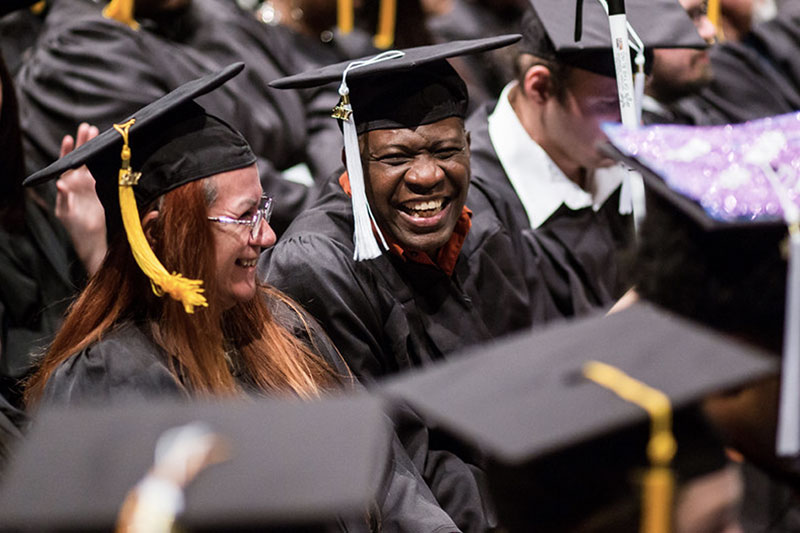New certificate in guided pathways implementation will strengthen faculty members’ ability to ensure student learning and persistence
New York, NY and Washington, DC (September 5, 2019)—Sova and the Association of College and University Educators (ACUE) today announced their collaboration to strengthen the guided pathways movement. A new, jointly developed certificate in guided pathways implementation will bolster faculty engagement and co-ownership of this national reform effort. This credential and its associated training will focus on best practices that ensure student learning and persistence to completion—pillars three and four of the guided pathways model.
“To date, those serious about implementing guided pathways at scale have made significant progress on the structural challenges institutions face in the work, including mapping programs of study and redesigning advising,” said Alison Kadlec and Paul Markham, Sova’s founding partners. “But not nearly enough has been done to meet faculty where they are, speak to their interests, and bring them into this work as true partners. Our collaboration with ACUE aims to address this gap and help the guided pathways movement to have the strongest possible impact on student success.”
“It’s hard to overstate the influence of faculty on students’ career interests, choice of program, depth of learning, and determination to complete their studies,” said Penny MacCormack, ACUE’s chief academic officer. “We’re going to ensure that faculty have a rich understanding of their role in guided pathways and are equipped with evidence-based teaching approaches.”
Sova and ACUE have commenced a year-long research and design process with experts in guided pathways and with faculty and administrators from leading pathways institutions. The new certificate will be available next fall.
“One of the still-dominant characteristics of college teaching is its isolation,” said George L. Mehaffy, former Vice President for Academic Leadership and Change at the American Association of State Colleges and Universities. “Social and disciplinary norms discourage faculty members from talking to one another about their teaching, and certainly from talking about their failures. So, it’s hard to create opportunities for faculty to learn from one another and to grow as professionals in the absence of feedback, new ideas, and space for experimentation. The model ACUE has developed brings together the best experts in the country to prepare high quality materials, but then faculty control the local environment. Faculty themselves co-create the learning community where they’re talking to one another and they’re using their own classes to try out and fine tune the evidence-based teaching approaches they’re learning. The results of ACUE’s approach have been impressive, and I’m glad Sova and ACUE are working together to deepen faculty engagement and ownership in the work of colleges and universities becoming truly student focused.”
“We’re honored to support the pathways movement with Sova as our partner,” said Jonathan Gyurko, ACUE’s president and co-founder. “They bring a wealth of insights as convener of the Guided Pathways Collaborative and from years of faculty engagement work—all of which will inform our new certificate.”
###
About Sova: Sova’s mission is to accelerate the pace and improve the quality of complex problem solving in higher education and workforce development. Driven by a core commitment to advancing genuine socioeconomic mobility through education, we help higher education leaders seize opportunities and avoid pitfalls as they move from strategy to action, from solution to implementation, and from pilot to scaled intervention. Sova pursues its mission through distinctive approaches to change leadership, process improvement, and business planning.
About ACUE: The Association of College and University Educators (ACUE) believes that all college students deserve an extraordinary education and that faculty members play a critical role in their success. In partnership with institutions of higher education nationwide, ACUE supports and credentials faculty members in the use of evidence-based teaching practices that drive student engagement, retention, and learning. Faculty members who complete ACUE courses earn certificates in effective college instruction endorsed by the American Council on Education. ACUE’s Community of Professional Practice connects college educators from across the country through member forums, podcasts, and updates on the latest developments in the scholarship of teaching and learning. To learn more, visit www.acue.org.
Kadlec: You have dedicated your career thus far to access-oriented regional comprehensive universities. Why has that sector been so important to you and to the future of our democracy?
Mehaffy: Well, it’s been important to me because most institutions in the United States, our education institutions, reify privilege. They take kids who already have advantages and they perpetuate those advantages, and that advantage becomes the status quo—in this case, deep inequity. So, I’ve always been intrigued by the institutions that seek to offer opportunity rather than reinforce privilege.
The reason it’s important for our democracy is because we are confronting an enormous polarization in this country. One form of polarization is economic inequity, which operates in ways that make it increasingly difficult for a middle class to survive and thrive. We seem to be pushing people either down or up, and we know that democracies do best when there is a strong and robust middle class.
What I essentially argue is that this collective effort of ours to promote greater student success, the focus particularly on removing barriers to student success, is critical if we want our institutions to serve as the engines of economic and social equity that our democracy needs. And it not only makes a difference to the individual and his or her family, but it makes a difference to our institutions, because our kinds of institutions are going to increasingly be serving with students who are less than “well prepared” by traditional standards, while at the same time being tuition dependent as their primary source of funding. And one of the things that I believe is that many of our institutions are going to survive or die depending on whether or not they are successful in helping students who have been historically excluded from higher education get degrees and graduate and move on into their first career opportunities. My conviction is that if you want to make a real impact in America and in our economic circumstances, in our culture, in our society, in our democracy, these are the institutions that really are going to make a difference.
Kadlec: It’s wonderful to see the “student success” movement, the movement to put students’ interests first, beginning to gain traction in the four-year space. Regional four-year comprehensive institutions have been described in recent decades as the workhorses of higher education with respect to closing wealth gaps and creating opportunity, and increasingly flagships are turning their attention to the equity imperative, but the student success movement has only begun to penetrate the walls of these institutions. I’ve heard you talk about colleges and universities being “held hostage” by longstanding beliefs – say more about that.
“We teach disciplines, and disciplines are ways of knowing, but they happen to be, in many respects—particularly for undergraduates—pretty lousy ways of organizing knowledge because students don’t experience life as neat, bounded disciplines.”
Mehaffy: The single best title that I ever put on an article was one that I did back about 2012, and I was describing this very thing that you’re talking about. The title was “Dungeons and Dragons: Imprisoned by our Own Beliefs, Tyrannized by Mythical Beasts.” We are essentially prisoners of our own circumstances. We created the institutions we’re in. Winston Churchill said it best when, during the rebuilding of the Parliament building after the War he said, “We shape our buildings, and in turn are shaped by them.” In this case, we shape our institutions, and in turn are shaped by them. So, there are a whole set of beliefs about students and about the way we do business that are deeply problematic and run counter to our responsibilities.
Probably the most powerful belief that shapes these institutions is the notion of student failure, and the assumption that failure is natural. That leads to the idea that the role of colleges and universities is to serve as mechanisms for sorting students in and out of higher education according to their inherent ability as evidenced by their perceived level of preparation. Even in access-oriented institutions the belief is deeply rooted that there is a normal distribution that sorts some out of higher education and some in. But what if the job isn’t to sort people out, but to give everyone a chance to succeed? Even more radically, what if we taught to mastery, instead of allowing the curve of the “normal” distribution to determine students’ outcomes?
Kadlec: What I hear you saying is that we’re imprisoned by a false notion of meritocracy – that institutions have historically told themselves that if students succeed or fail, it is because of the students’ inherent merit or lack thereof. They take students as they are, and sort some in and sort some out. But this belies the notion that students enter college on a level playing field, and it fails to recognize that colleges and universities bear responsibility when it comes to providing equitable opportunity to those students that have been historically marginalized and systematically excluded from higher education: low-income students, first-generation students, and students of color from minoritized populations. To me, dispelling the myth of meritocracy is the first step on the road to real, institutionalized commitment to student success. I hear you say the same thing here.
Mehaffy: Right, exactly. A lot of our institutions talk a good game about being student-centered, but I would argue that most are not student-centered. If they were, every single question that’s debated would be debated around the question of “Is this good for students?” Not, “Is this good for us?” Or, “Is this more convenient for us?” Or, “Is this what we love to teach?” It’s so deeply held that we create our institutions for ourselves, and so ingrained that we operate in ways that prioritize our interests, that it’s hard to almost imagine what it would be like if we didn’t operate that way. We teach disciplines, and disciplines are ways of knowing, but they happen to be, in many respects—particularly for undergraduates—pretty lousy ways of organizing knowledge because students don’t experience life as neat, bounded disciplines.
“Allegiance to a discipline and allegiance to student success can be at odds with one another. They don’t need to be, but they can be. This is part of the reason why I call student success work deeply counter-cultural.”
Kadlec: As I’m listening to you, I’m thinking about my own path out of academic and into mission-driven student-focused reform work. It’s nothing short of cognitive dissonance for faculty who care deeply about professing their discipline to think about the way in which our deeply engrained conflation of creative autonomy and academic freedom can be harmful to students. Of course, academic freedom is profoundly important – particularly in our political climate – but to argue that any effort to ensure students receive consistently, high-quality and coherent educational experiences is necessarily a violation of academic freedom worries me greatly. We have not had those first-order conversations about what it means to have one’s identity anchored in a commitment and a passion for a discipline, and what it means to cultivate that passion in the context of caring first and foremost about what’s best for students.
Mehaffy: I think you’re absolutely right. Allegiance to a discipline and allegiance to student success can be at odds with one another. They don’t need to be, but they can be. This is part of the reason why I call student success work deeply counter-cultural. It operates as a challenge to the status quo. It operates as a challenge to the historical traditions of the academy in many respects.
Kadlec: In our work helping faculty become true co-owners of the hard work of change on behalf of students, we see again and again that faculty members, on the whole, are enormously creative and eager to do better by their students but often lack the support to do so. We know that many faculty are feeling beleaguered, but so many are nonetheless driven by a deep desire to find ways of being more effective in fostering learning in an increasingly diverse student population. And we know that without their creative commitment, even the most promising interventions are bound to fall short. You and I have talked a bit about what higher ed can learn from healthcare, and particularly the last decade of research on patient-centered care. Can you say more about that here?
Mehaffy: My hero in this regard is Atul Gawande.
Kadlec: Aha! I shouldn’t be surprised that we share this hero, but I am surprised we haven’t talked about this before.
Mehaffy: So much of his work in healthcare shows what it takes to shift culture and practice in service improved outcomes for patients. Higher ed has much to learn from research in health care, and people like Gawande are showing what kinds of interventions and strategies are most effective in challenging deeply entrenched beliefs that run counter to the interests of patients, and what it means to create the conditions for changing deeply engrained practices. Whether it’s about creating protocols for surgery that allow for medical staff to hold each other accountable regardless of established hierarchies, or about using data to challenge long-held beliefs about where the greatest gains are being made in extending life expectancy for people with cystic fibrosis, Gawande’s insights apply far beyond healthcare. We’d all be better served by reading him more carefully and by asking ourselves what it would mean and what it would take to have community-developed, evidence-based standards of care in higher education that bring together the insights of leadership, faculty, staff and students themselves in service of improved outcomes.
“I think Sova is doing some of the most important work in the country with respect to student success.”
Kadlec: Amen. We find ourselves reading and referencing research in patient-centered healthcare for lots of different reasons, not least of which is because of how clearly it shows that creating a true “culture of care” requires the active commitment and creative co-ownership of frontline practitioners. Leadership from the top is not enough to effect the changes needed, and passive ‘buy-in’ isn’t either, but this is a great puzzle because it deprives us of all easy answers about how evidence-based ideas become real solutions with real outcomes.
Mehaffy: Exactly, and we’ve talked a bit in other conversations about why generic leadership training programs don’t serve the needs of public access-oriented higher education institutions particularly well. Most leaders, presidents and provosts, realize or learn quickly that they don’t live in a ‘command-and-control’ world in which change can be effected without with distributed leadership.
Kadlec: Indeed. This is why we’re always preaching the importance of cross-silo skill-building for adaptive leadership, which is a lot different than merely ‘managing’ change. So, by way of wrap up here, I want to ask you why you’ve decided to join Sova for the next chapter of your career. How did we get so lucky?
Mehaffy: Well, I’ve become enormously committed to this notion of student success, and to get to student success requires institutional transformation. It requires changes in policies, it requires changes in practice and in mindset. As you described just now, it requires enormous leadership at multiple levels, and it requires a culture that supports student success in the most fundamental ways. This is not easy work. As we said, it’s counter-cultural. As I began thinking about life after AASCU, I looked around at organizations and found only one that I thought was really doing the kind of deep analytical and insightful work that’s required to make a fundamental and profound change in institutional behavior, and that was Sova.
Of course, I’ve known you all for a long time. Paul [Markham] was the first recipient of and “Emerging Leaders in Civic Engagement” award we created through the American Democracy Project more than a decade ago. And over the years while you were at Public Agenda, I’d gotten to know you, too. But it’s what you’re doing together with Sova, and the talented team you’ve put together, that really interests me. I think that there are few organizations out there that are well equipped, and with the kinds of professional histories that you all bring, to do the work that needs doing. I think Sova is doing some of the most important work in the country with respect to student success. And that’s why I was immediately drawn to you all as an outlet for my continuing intrigue about this notion of how we help many more students graduate and thrive, particularly those students for whom the playing field has not yet been leveled.
Kadlec: Well, George, we are honored and excited for the next chapter together. As we often say to one another at the end of emails: Onward!




